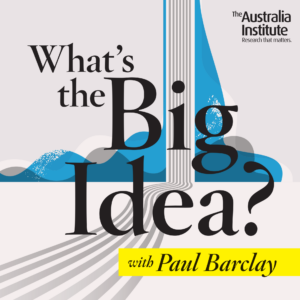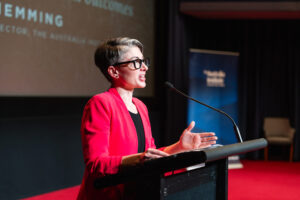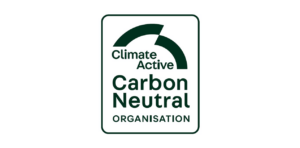Unlike in almost any other country, Australia’s corporate greenwashing is being facilitated and encouraged by government. By Polly Hemming

Paul Ekins is laughing but he’s clearly also rattled. “I have to hand it to Australians,” says the professor of resources and environment policy at University College London. “You always deliver the most shocking news in such an entertaining way.”
For the past 20 minutes, I have been standing at the lectern at Oxford’s Queen’s College, scrolling through slides featuring the supposedly “carbon neutral” claims made by Australian fossil fuel companies and products.
Most of the people in the room are, like Ekins, veterans of climate policy and research. I doubted anything I would say could shock them. But as I worked through the presentation, I realised I was wrong. In front of me, as I explained how these claims were enabled in Australia, I was met by disbelieving looks.
To be clear, fossil fuel companies everywhere promote themselves as climate leaders. The difference here, and the news that stunned this room, is that in Australia the government is not only in on this game, but it is also running it.
Despite Australia’s commitment to net zero by 2050, there are more than 100 new fossil fuel projects in development nationally. Just as committed to gas and coal expansion as industry, but with its own net-zero target to meet, the Australian government provides an entire policy framework under which misleading climate claims thrive. Creative accounting, offsets and their misuse have been nationalised in Australia, amounting to state-sponsored greenwashing.
“A carbon neutral oil and gas company?” asks Clemens Kaupa, an assistant law professor at Vrije Universiteit Amsterdam. “No, that’s ridiculous.”
Kaupa is referring to a claim by fossil fuel company Cooper Energy that it is Australia’s “first carbon neutral gas producer”.
Kaupa has particular expertise in this area. Last year, he and his students successfully filed a greenwashing complaint against Shell’s “carbon neutral” petrol with the Netherlands’ advertising watchdog. Shell was subsequently required to stop using the term “carbon neutral” to describe its products.
The Netherlands accepts it is not physically possible for fossil fuels to be “carbon neutral”, but in Australia carbon neutral petrol is considered a legitimate premise. In fact, Australia’s own advertising watchdog last month dismissed a similar complaint against Ampol’s promotion of “carbon neutral” petrol.
According to Kaupa, Ampol’s advertisement would likely be found misleading in the Netherlands: Shell and Ampol’s products, and the standards used to assess the claims, are the same. Yet one product has been deemed greenwash and the other not. What may explain the difference is that, internationally, most companies making carbon neutral claims are doing so voluntarily. In Australia, Ampol’s petrol has been endorsed by the government through its carbon neutral certification scheme Climate Active.
Despite Australia’ s commitment to net zero by 2050, there are more than 100 new fossil fuel projects in development nationally.
Ampol achieved its certification by calculating the greenhouse gas emissions from extracting, refining and combusting petrol and then offering customers the opportunity to offset the emissions from the petrol they buy. Not all Ampol’s petrol is carbon neutral, nor is it offsetting the emissions from the rest of the company. To date, Ampol has reported purchasing about 80,000 offsets. The emissions from Ampol’s products in 2021 were 41 million tonnes of carbon dioxide equivalent, or CO2-e, with the company’s total emissions being 54 million tonnes CO2-e. CO2-e is a way of measuring greenhouse gases from different sources using a single unit, to calculate their global warming potential.
Companies such as Cooper Energy, which make the bolder claim of being a “carbon neutral organisation”, use a different technique, choosing to offset the emissions only from their business operations (4000 tonnes of CO2-e in 2021), including business travel and office stationery, while carving off the emissions that come from actually burning their fossil fuel products (close to a million tonnes of CO2-e). Cooper Energy is accounting for less than 1 per cent of its emissions here and also plans to dramatically increase its gas production through to 2030 and beyond.
Ignoring the role fossil fuel companies have and continue to play in the climate crisis, Climate Active endorses the companies it certifies as having gone “beyond standard practice and set themselves apart as climate champions”. Among these companies is Australia’s biggest polluter, AGL.
“AGL has been Climate Active certified since 2020,” says Harriet Kater, climate lead (Australia) at the Australasian Centre for Corporate Responsibility, “ and its investors, customers and the wider community would all agree the company has been the very opposite of a climate champion over the last two years.”
The Australian government doesn’t just rubberstamp carbon neutral claims; it provides a ready supply of carbon offsets that industry can use to underpin them. Yet the Emissions Reduction Fund – the framework generating these offsets – has been beset by controversy. Experts suggest about 75 per cent of the offsets are junk and are, in fact, not offsetting anything. Ampol uses Australian carbon offsets that are currently the subject of an independent review.
Beyond Climate Active, corporate claims of carbon neutrality and net-zero climate targets generally are growing rapidly in Australia. Last year, the number of listed companies in Australia making net-zero commitments doubled. Despite this growth, emissions from burning fossil fuels in Australia continue to increase, demonstrating a clear disconnect between pledged and actual climate action.
Rising emissions are unsurprising when industry greenwashing appears to be so rampant. The interpretation of climate ambition by the private sector varies greatly and has resulted in climate claims that make it virtually impossible to distinguish who is actually acting in good faith and who is not.
Australia’s financial regulators have finally acknowledged the confusion and risk this landscape poses to consumers and investors. The Australian Competition and Consumer Commission, Australian Securities and Investments Commission and Australian Prudential Regulation Authority have all announced a crackdown on greenwashing in the past year. The ACCC’s chair, Gina Cass-Gottlieb, has flagged that as many as 42 per cent of green claims in Australia may be fraudulent or misleading. ASIC’s deputy chair, Karen Chester, told members of parliament this month that the financial regulator was already carrying out investigations in response to a reported uptick in greenwashing. “ASIC’s job there,” Chester says, “is to have a look at that and say: ‘That’s very interesting. You show us how you’re going to achieve that…’”
While such announcements may comfort investors and consumers, what is unclear is how successful efforts by government regulators will be, given that it is the Australian government itself giving a tick of approval to misleading claims and providing the offsets and accounting frameworks used by industry to mislead. Experts fear Australia’s regulators will be unable to successfully tackle greenwashing when the system is broadly functioning as it was intended to.
When Cooper Energy makes a carbon neutral claim, it doesn’t just protect its social licence, it also protects the government subsidising gas expansion while simultaneously reassuring fire- and flood-stricken communities that they are taking climate change seriously.
Kirsty Ruddock, a managing lawyer at the Environmental Defenders Office, who filed the complaint about Ampol on behalf of activist group Comms Declare, says: “It is no accident that a fossil fuel company in Australia can claim to be a carbon neutral organisation at the same time as telling shareholders it will be ramping up oil and gas production. This is the result of policy design and an absence of environmental standards.”
Although the rhetoric of climate policy has shifted significantly since the Morrison government lost office, the reality is Australia’s commitment to fossil fuel expansion hasn’t shifted at all. The Australian government has set the standard for the likes of Ampol and Cooper Energy to continue polluting for decades with the help of creative climate accounting and offsets rather than actual decarbonisation.
Labor promised a slightly more ambitious emission reduction target for 2030 than the former Coalition government, but its increase in ambition is at odds with its ongoing support for gas and coal. Labor has refused to block new fossil fuel projects and has not ruled out the billions in subsidies that go to fossil fuels every year. The government’s key climate policy, the revived Safeguard Mechanism, places no requirements on industry to reduce emissions. It is based around allowing them to offset emissions instead.
Greenwashing is not new in Australia, but the last election has made it more important. Labor’s more ambitious rhetoric, and its promise not to introduce either a carbon price or a ban on new fossil fuel projects, makes the gap between rhetoric and reality even wider than it was for the Coalition.
The jumbled relics of policy architecture set up by previous governments, including the Safeguard Mechanism, the Emissions Reduction Fund, creative accounting frameworks and, of course, Climate Active, form the basis of the state-sponsored greenwash being used to avoid the political pain and economic shifts that will be inevitable with genuine decarbonisation.
As countless corporate failures have shown, however, creative accounting can delay the inevitable but not defeat it. If the world is to succeed in its goal of reducing greenhouse gas emissions, Australia must fail in its goal of increasing fossil fuel production and exports. Carbon neutral petrol and gas companies might make for good short-term optics, but they do nothing to prepare Australia for long-term reality.
Between the Lines Newsletter
The biggest stories and the best analysis from the team at the Australia Institute, delivered to your inbox every fortnight.
You might also like
We need political courage, not caution | Polly Hemming
When it comes to solving the biggest national problems, a bit of courage leaves political caution for dead. Now’s not the time for politeness.
Integrity at home shapes global outcomes – Polly Hemming | Climate Integrity Summit 2025
Despite frequent claims that Australia is ‘too small to make a difference,’ historical evidence demonstrates our nation’s outsized role in influencing international norms and policies.
State sponsored greenwashing misleading consumers and failing businesses
Civil litigation over alleged greenwashing by Energy Australia reveals the Australian government is failing to protect consumers and businesses from misleading claims and harmful practices.



